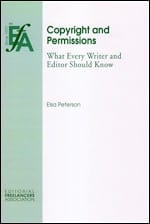Q: “I am currently writing on my own but considering taking on a coauthor. What are some different ways that…
How to reach out to potential textbook publishers
Q: “I am interested in researching the types of textbooks that currently exist regarding preparing a student for a job…
Insights on working with editors: An interview with Elsa Peterson
 Elsa Peterson has more than 20 years of experience in textbook and academic publishing as a freelance permissions editor, picture researcher, and developmental editor. Her most recent in-house position was as a senior developmental editor for psychology with McGraw-Hill Higher Education. Peterson recently authored a brief and accessible guide to copyright in the context of publishing titled Copyright and Permissions: What Every Writer and Editor Should Know (New York: Editorial Freelancers Association, 2012). She has also authored numerous articles about the business and craft of editing, and has presented TAA audio conferences on editing and copyright.
Elsa Peterson has more than 20 years of experience in textbook and academic publishing as a freelance permissions editor, picture researcher, and developmental editor. Her most recent in-house position was as a senior developmental editor for psychology with McGraw-Hill Higher Education. Peterson recently authored a brief and accessible guide to copyright in the context of publishing titled Copyright and Permissions: What Every Writer and Editor Should Know (New York: Editorial Freelancers Association, 2012). She has also authored numerous articles about the business and craft of editing, and has presented TAA audio conferences on editing and copyright.
Completing a major textbook revision: The after-the-fact outline
The after-the-fact outline provides a valuable strategy to help complete a major book or article revision. Sometimes referred to as a reverse outline, I learned of this strategy from Tara Gray, author of the book Publish and Flourish. I have tried most of the advice in her book, and now that I have tried this piece of advice, I had to ask myself: “Why did I wait so long?”
The first thing to point out is that this strategy is not a writing strategy, but a revising strategy. This strategy works best when you have a draft of your article (or a portion of your article) and are ready to rewrite it. It is best if your draft is rough, as you need to feel comfortable with the idea of deleting and/or rearranging large portions of it.
Featured Member Ric Martini – A veteran textbook author’s insights on contracts, author collaboration & more
Frederic (“Ric”) Martini received his Ph.D. from Cornell University in comparative and functional anatomy for work on the pathophysiology of…
How to apply for copyright
Lisa Moore, Principal, The Moore Firm, LLC:
“It’s very easy to apply for a copyright registration. You can do it online. The Copyright Office’s website is actually an excellent resource.
The process is changing. Back in the day, you had to fill out the form depending on what you were registering. The Copyright Office changed that, and they’re now utilizing one common form that can be done online. It’s much cheaper that way, $35 and you get your registration back much more quickly. If you mail in the old paper forms it takes somewhere between a year and two years to get it back, but if you do it online it’s somewhere between three and six months.






